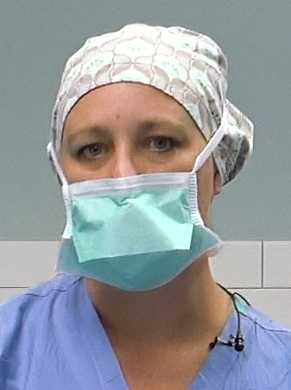Surgical Technologist Prepares the OR for a Case
Abstract
Establishing a sterile field, opening and organizing equipment and supplies, and preparing the operating room (OR) for a case are the foundations for ensuring an environment conducive to a safe and efficient operation. Surgical donning of gown and gloves is an integral component of infection control in the OR. Healthcare professionals must adhere to strict protocols to protect both patient and healthcare worker safety. Proper training, vigilance, and attention to detail are crucial in maintaining a sterile environment before and during surgical procedures. This article explores key considerations for healthcare professionals as they open up surgical equipment, establish and maintain a sterile field, doff and don gowns and gloves, and prepare the OR for a surgical procedure.
Introduction
Infection control is paramount in the high-stakes environment of the operating room (OR). Surgical site infections lead to serious complications for patients and are a significant concern for healthcare providers. Proper surgical doffing and donning procedures are essential to minimize the risk of contamination and maintain a sterile environment.1, 2 The role of surgical technician plays a crucial role in preparing for a surgical case in the OR.
Key Roles and Responsibilities
Unpacking Medical Equipment and Supplies
Envelope-folded Packs: Always check the integrity of each pack prior to opening it. When opening an envelope-folded package, adhere to the following:
- Open away from yourself first, then towards yourself.
- Open both sides, selecting the left or right side based on the orientation of the fold. Gently position your hand beneath the fold and unfurl the package in the direction of your hand placement.
- Remember to never cross over the sterile supply.
Gown: This will also be envelope-folded; slightly pulling each tab will help it to lay flat from memory.
Gloves: Open your top glove first, then your indicator so that it is the first glove you have easier access to when you go to gown.
Opening Sterile Kit
Always check the integrity of the indicators on the exterior of the caskets to ensure the color has changed. Open the casket with the unsterile side towards yourself. If your caskets have additional filters inside, always check them for indicator change and that they are intact.
Donning Gown and Gloves
Be mindful to not touch the outer wrapper below your gown when picking it up so the wrapper stays sterile when your gloves fall off the gown and onto it.
Once you are gowned/gloved, while turning with an unsterile person, remove the left tie and hand the card (with the right tie still in it) to a non-sterile person for them to walk around you. Pull the tie out of the card they are holding without touching it and tie your gown to the left hip.
Tying with two sterile individuals: when you turn with another sterile member of the surgical team, both parties can touch either tie/card and complete the turn.
If your facility has reusable gowns and the person you are turning with is unsterile, you can take the wrapper from your gloves and place the right tie into the paper wrapper and hand it to the unsterile person to walk around you; then pull it out without touching the paper again and tie it to your left hip.
Back Table Setup
Removing instruments: Make sure to visualize and check the indicator strip inside the casket and make sure that there is nothing unexpected within the pan. The inner pan needs to be lifted straight up to ensure you don’t come in contact with the sides of the pan (unsterile). Lastly, look inside the bottom of the casket to ensure it is also clean/sterile.
Organization: How the back table is organized will depend on surgical technologist, surgeon, and institutional preferences as well as what case is being performed. However, the layout for a basic table setup can be seen in the accompanying video.
Counting:
Soft Goods: Remove the paper wrapper only when you are going to immediately start counting them; separate each item completely from the next so the non-sterile counting individual can easily see them.
Instruments: Keep the stringer in place until you have completed the instrument count; it is best practice to state the instrument first, then count the total so that the documenting individual knows that you are moving to the next instrument.
Doffing Gown and Gloves
Remove your outer gloves first, break the tie at the side, break from the waistline, and pull from the back forward rolling down towards your hands. It is possible that your gloves will come off with your rolled gown, but if not, when you go to remove them, make sure to remove one dirty glove by the other dirty-gloved hand, and then your clean hand to your opposite clean hand, and pull them off.
Discussion
One of the most important responsibilities of a surgical technologist is to establish and maintain the sterile surgical field. Opening and organizing equipment and supplies and readying the OR for an upcoming case involves attention to detail, vigilance, and adherence to strict protocols. Surgical donning of gloves and gowns for yourself and others is an essential part of infection control. Maintaining sterility and organization are the most important factors in providing a safe and efficient setting for a surgical procedure. This sets up everyone, most importantly the patient, for success.
Disclosures
Nothing to Disclose.
Citations
- Garg K, Grewal A, Mahajan R, Kumari S, Mahajan A. A cross-sectional study on knowledge, attitude, and practices of donning and doffing of personal protective equipment: an institutional survey of health-care staff during the COVID-19 pandemic. Anesth Essays Res. 2020 Jul-Sep;14(3):370-375. doi:10.4103/aer.AER_53_20.
- Furtado SV, Perikal PJ, Narayanaswamy M, Ravikumar TV, John L, Harish K. Assessing efficacy of instructor based orientation to donning doffing protocols and modifications to doffing area infrastructure in reducing SARS-CoV-2 infection among doctors assigned to COVID-19 patient care. Infect Prev Pract. 2023 Jun;5(2):100279. doi:10.1016/j.infpip.2023.100279.

